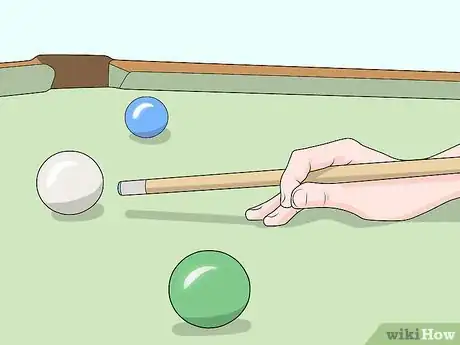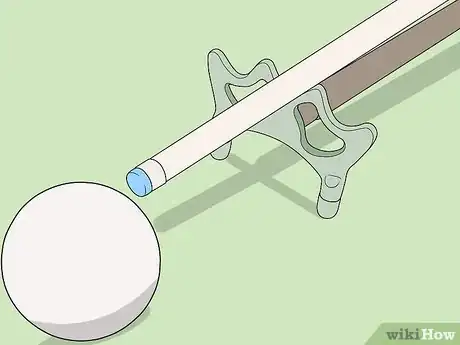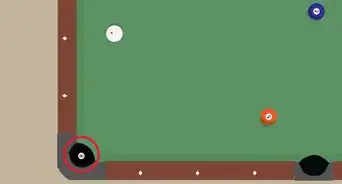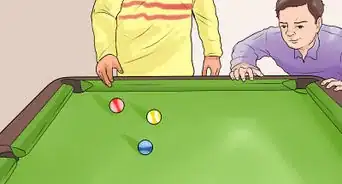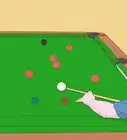This article was co-authored by wikiHow Staff. Our trained team of editors and researchers validate articles for accuracy and comprehensiveness. wikiHow's Content Management Team carefully monitors the work from our editorial staff to ensure that each article is backed by trusted research and meets our high quality standards.
There are 10 references cited in this article, which can be found at the bottom of the page.
wikiHow marks an article as reader-approved once it receives enough positive feedback. In this case, 94% of readers who voted found the article helpful, earning it our reader-approved status.
This article has been viewed 428,383 times.
Learn more...
Snooker is one of the most popular parlor games in the world. A variation of billiards, it is played on a felt-covered table with six pockets lining the perimeter. The object of the game is to sink a group of colored balls in the correct order using a thin wooden cue. Snooker requires considerable precision and concentration, and the complexity of its rules makes it harder to master than other forms of billiards like pool. Once you get the hang of it, however, Snooker plays much like other beloved billiards games and is a fun way to challenge your sense of spatial awareness and control.
Steps
Learning the Rules
-
1Score more points than your opponent to win. In order to secure victory in a game of snooker, you have to end the game with a greater number of points than the other player. This means that you should try to secure as many points per turn as you can. Snooker can be tricky to get the hang of at first, but with time you’ll learn how to place your shots to run the table and make the best of each turn.[1]
- There are 22 balls total used in a game of snooker: 15 red, 6 multicolored (yellow, brown, green, blue, pink and black) and a single white “cue” ball, which is used to pocket shots. The point value of each ball is as follows: all red balls =1, yellow = 2, green = 3, brown = 4, blue = 5, pink = 6 and black = 7
- Players score points every time they successfully sink a ball. By the end of the game, every ball must be in a pocket for there to be a winner. Because of the player's ability to pocket colored balls repeatedly during the opening stage of the game, a winning score will rarely be below 50.
-
2Set up the table properly. Before you can begin playing, the balls must be arranged in the right configuration. Each of the colored balls has a specific location on the table. The 15 red balls are arranged in a triangular formation at one end of the table, with the pink ball directly in front of the point of the triangle and black ball a few inches behind the red balls. The blue ball rests in the center. The yellow, brown and green balls are lined up horizontally on the breaking end of the table.
- Whichever player begins the game will break from the end of the table opposite the cluster of red balls.
Advertisement -
3Decide which player will break. Flip a coin or come to an agreement on who will shoot first. This player will be responsible for breaking the formation of balls. For their opening shot, the player will position the white cue ball behind the line of yellow, brown and green balls. They will then aim to gently dislodge a red ball from the cluster, officially starting the game.[2]
- Unlike in pool, where the object of the break is to scatter the balls across the table, a snooker break should be conservative. That way, your opponent won’t have the advantage of multiple shots should you miss.[3]
- The cue ball can be placed anywhere within the D-shaped semicircular section of the table.
-
4Alternate between red and colored balls to earn points. Points are scored by sinking the right balls in the right order. The active player will attempt to pocket a red ball first. Once sunk, red balls remain where they are. The player will then aim for any of the colored balls, which are returned to their designated spot on the table after they’ve been pocketed. Continue the game in this manner, going back and forth between red and colored balls, until all of the red balls have found their way into a pocket.[4]
- A player’s turn is over if they miss a shot.[5]
- If a player scratches (pockets the cue ball by mistake, or fails to hit a single colored ball) or shoots a ball in the wrong order (for instance, two colored balls in a row), it’s considered a foul. Typically, they lose their turn, and in competition there may also be a point deduction.
-
5Pocket the rest of the colored balls in the correct order. After all of the red balls have been pocketed, a player can close out the game by consecutively sinking the remaining colored balls in order of their point value. In this stage of the game, the balls no longer go back to their original position. If one player misses, it becomes the other player’s turn. The game is over when there are no more balls on the table.[6]
- Following the red balls, the colored balls must be deposited in this order: yellow, green, brown, blue, pink, black.
- Since missed colored balls stay on the table in the final stages of the game, it becomes a free-for-all to see which player can snag the most points.
Making Shots
-
1Take a comfortable grip. Grab the cue near the bottom of the thick, weighted end. The closer to the end you grip, the more control and extension your shots will have. Make sure your hand placement is comfortable and secure to prevent the cue from drifting when you’re aiming.
- Snooker cues tend to be somewhat heavier and have narrower tips than the cues used in other forms of billiards. With a slender tip, the player can manipulate the cue ball more precisely.
- How high or low you choose to place your hand on the cue is mostly a matter of personal preference.
-
2“Bridge” the cue with your non-dominant hand. Lay your non-shooting on the table and use it to guide the cue as you shoot. Most people prefer to use either an “open bridge” (lining up the cue across the groove of the thumb joint) or a “closed bridge” (enclosing the end of the cue between their thumb and pointer finger). Bridging helps you steady the cue as you strike the cue ball, allowing you to place your shots with more precision.
- Use a solid bridge to keep your cue from wiggling around during your stroke.[7]
- Elevating your bridge by lifting the bottom of your hand off the table can enable you to pocket balls that are too close to the rails or other balls.
-
3Move the cue in a smooth, straight line to shoot. In one tight, controlled motion, draw your shooting arm back a few inches and thrust it forward, hitting the cue ball in the upper part of its center. Keep your elbow relaxed and close to your side. Try to make your movements as fluid as possible. A jerky or halted stroke will most likely be inaccurate.[8]
- Practice shooting straighter by bouncing the cue ball off one of the rails and seeing how closely it returns to the tip of your cue.
-
4Use a precise stroke to place the balls into pockets. Sink balls by shooting them straight for the pockets, or striking one side of the ball so that it rolls in at an angle. You can also use the rails, or the edges of the tables, to bounce balls into pockets on the same side of the table you're shooting from. The balls will be in many different positions throughout the game. Take some time to line up your shots every time it's your turn at the table.[9]
- Keep your eye on the ball as you line up your shot, and don’t let your shoulders come up until you’ve completed your stroke.
- Calculate the angle you need to strike the ball in order to knock it into a given pocket by aiming for the point on the ball that's directly opposite the pocket's opening.
-
5Use extensions to assist with difficult shots. Because of the size of a snooker table, and the number of balls cluttering the table, there may be times when it’s impossible to make a successful shot using the standard technique. In the situations, an extension tool such as a "rest" (also known as a “bridge”—not to be confused with the hand position used while aiming) or "spider" will come in handy. Rests resemble normal pool cues with the exception of an arched stand at the end. The player’s cue can be fitted into this stand, which takes the place of the bridging hand for steadying shots.[10]
- A rest is a valuable aid for making shots that would otherwise require you to lean across the table.
- The spider extension has a higher arch, and should be used in situations where the cue ball is too close to a ball or group of balls to give you a clear shot.
Playing a Winning Game
-
1Calculate the value of each shot. Red balls are worth 1 point each. The remaining colored balls are worth an increasing number of points in sequence. Remember, these balls can be pocketed multiple times before the end of the game, which will help you quickly drive up your score. The fixed position of the colored balls means you should always have a clear shot at one, no matter where the cue ball is on the table.[11]
- Players should either keep score mentally or have a pen and paper nearby to record the number of points earned after each turn.[12]
- If the losing player’s score is so much lower that it’s impossible for them to close the gap by the time all the red balls have been cleared from the table, it’s customary for them to forfeit to the winning player.
-
2Plan your shots strategically. As you assess the table, make it your goal to sink a red ball that will leave you with a follow up shot at one of the colored balls. Keep in mind the value of each ball and go for the ball that will earn you the highest number of points whenever you can. Use an appropriate amount of power for each shot so that the cue ball comes to a stop as near as possible to the center of the table. This way you’ll always have an unobstructed path.[13]
- The ability to use one shot to set up the next is the hallmark of a skilled snooker player.
-
3Play it safe. In general, it’s best not to take unnecessary risks. By staying composed and opting for modest, well-executed shots, you can keep your turn going longer, putting you in control of the table. Look over the entire table and determine what your best option is before trying to pocket a ball at a distance or angle you’re not sure you can make.[14]
- The closest shot will usually be the easiest.
- Avoid sharp angles or bank shots that require you to use the rails. The small size of the pockets makes it more likely that you’ll miss.
-
4Take your time. Snooker tables are quite a bit larger than standard billiard tables, and, to make it even more complicated, the pockets are slightly more narrow. For this reason, you should always pace yourself when picking, lining up and taking your shots. Being hasty or getting overly excited about scoring could cost you the shot, and if you’re playing against an experienced opponent, one missed shot could mean the end of the game.
- Regulation snooker tables measure 12’ (3.6m) long by 6’ (1.8m) wide, whereas most pool tables are only 8’ (2.4m) long by 4’ (1.2m) wide.
- Additionally, the pockets on a snooker table are about 1.5 (roughly 3.7cm) inches smaller than those on other playing surfaces.
Community Q&A
-
QuestionIs it against the rules for the white ball to hit a bank before it hits the object ball?
 Community AnswerIf by "bank" you mean the border, then it is not against the rules. You can hit the border before the you hit the object ball if your way is blocked.
Community AnswerIf by "bank" you mean the border, then it is not against the rules. You can hit the border before the you hit the object ball if your way is blocked. -
QuestionHow do I snooker someone easily?
 Community AnswerPot a red, but let the cue ball come back to the yellow green brown. Then gently place the cue ball behind one of those.
Community AnswerPot a red, but let the cue ball come back to the yellow green brown. Then gently place the cue ball behind one of those. -
QuestionHow do I play a bottom shot?
 Community AnswerPut a spin on the cue ball by hitting it with the cue off-center. If you hit the cue ball towards the base, you apply backspin and it will usually come back towards you. If you hit the ball towards the top, it will usually carry on. If the ball is struck slightly to left or right, it will usually swerve off in that direction after hitting the object ball.
Community AnswerPut a spin on the cue ball by hitting it with the cue off-center. If you hit the cue ball towards the base, you apply backspin and it will usually come back towards you. If you hit the ball towards the top, it will usually carry on. If the ball is struck slightly to left or right, it will usually swerve off in that direction after hitting the object ball.
Warnings
- Don't attempt to break your opponent's concentration during their turn by yelling, waving, standing in their way or any other distracting behavior. This is generally considered bad form.⧼thumbs_response⧽
- Keep your cool. Getting frustrated will just make it harder to focus.⧼thumbs_response⧽
- Use caution when trying to bank a shot in off the edge of the pocket. The pockets on snooker tables are curved, not flush like a pool table, which means it will simply be deflected off if your aim is not exact.⧼thumbs_response⧽
References
- ↑ http://www.billiardworld.com/snooker.html
- ↑ http://www.mastersgames.com/rules/billiards-snooker-rules.htm
- ↑ https://www.youtube.com/watch?v=PwSGdl_JgNg
- ↑ https://www.youtube.com/watch?v=PwSGdl_JgNg
- ↑ http://www.mastersgames.com/rules/billiards-snooker-rules.htm
- ↑ http://www.billiardworld.com/snooker.html
- ↑ https://www.youtube.com/watch?v=NtpV0qDGRqw
- ↑ https://www.billiards.com/article/the-stroke
- ↑ http://www.billiardworld.com/aiming.htm
- ↑ https://www.youtube.com/watch?v=hNzH6OLIJ3o
- ↑ https://www.youtube.com/watch?v=PwSGdl_JgNg
- ↑ http://www.rulesofsnooker.com/keeping-score.html
- ↑ http://snookerdelight.com/snooker-articles/tutorial-how-to-stop-missing-certain-angles-in-snooker/
- ↑ https://www.pooldawg.com/article/pooldawg-library/tips-for-better-all-around-pool
About This Article
To play snooker, you want to try to score more points than your opponent to win. To get points, you'll need to sink the balls on the table into the pockets. Red balls are worth 1 point, and the multicolored balls are worth 2-7 points, depending on the ball. When it's your turn, you have to sink a red ball before you can shoot for a multicolored ball. If you miss, it's the other players turn. Keep playing until you and your opponent have cleared all the balls off the table! If you want to learn how to properly set up a snooker table, keep reading the article!






